Tradition & Innovation
Hamill's Killer: A Canadian Variation
By Sheldon Seale
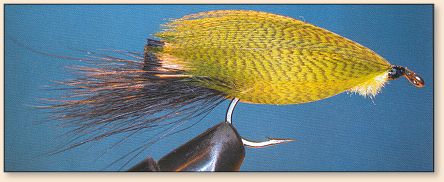
The Hamill's Killer is a New Zealand pattern
used very successfully (or so I'm told) on some
of the large lakes there. The late Maurice Howe,
a long time member of the Izaak Walton Fly Fishing
Club in Toronto, aware of this pattern's excellent
reputation, tried tying it from memory sometime
in the 1970s or 1980s. As it turned out, his
memory wasn't quite as accurate as he thought, and
he got the wing wrong. However, serendipity being
what it is, a Canadian pattern was born that has
proved to be just as effective as it's down under
predecessor.
The original Hamill's Killer was tied with wings on
the sides of the hook (one feather per side, see photo above),
which gave the pattern a nice silhouette. Howe tied
the wing flat on top, "killer" style, which, in the
1950s and 1960s, was a fairly standard term used to
describe patterns with one or two flank feathers tied
flat over the body as the wing. These include the
Canadian Killer and other related patterns.
Recipe
Hook: 3X or 4X long nymph/streamer type hook, sizes 10-2.
Thread: Black 6/0.
Tail: Black bear, sparse, under golden pheasant
tippet (half the length of the bear).
Body: Yellow chenille, medium, may be weighted.
Wing: 2 dark-green dyed mallard flank feathers, tied flat,
[shown yellow here.]
Throat: Grizzly hen hackle fibers or similar (optional).
Tying Step
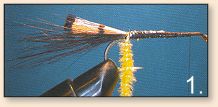 1. Weight your hook, if you wish, and at the bend,
tie in a sparse quantity of black bear (or black
squirrel tail) hair the length of the hook shank
for the tail. Add some golden pheasant tippet - the
same length. Expose the thread core of some medium
yellow chenille, and tie it in at the base of the tail.
1. Weight your hook, if you wish, and at the bend,
tie in a sparse quantity of black bear (or black
squirrel tail) hair the length of the hook shank
for the tail. Add some golden pheasant tippet - the
same length. Expose the thread core of some medium
yellow chenille, and tie it in at the base of the tail.
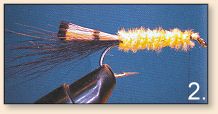 2. Wrap the yellow chenille forward in touching turns
to form the body. Leave enough room at the front for
the head and wing. Secure the chenille with thread,
and trim the excess chenille. If you wish to add a
throat, now's the time to tie it in. If you don't
add a throat, build up a little thread to smooth the
transition between the head of the fly and the body.
If you don't do this, you will have trouble keeping
the wing down over the back of the fly.
2. Wrap the yellow chenille forward in touching turns
to form the body. Leave enough room at the front for
the head and wing. Secure the chenille with thread,
and trim the excess chenille. If you wish to add a
throat, now's the time to tie it in. If you don't
add a throat, build up a little thread to smooth the
transition between the head of the fly and the body.
If you don't do this, you will have trouble keeping
the wing down over the back of the fly.
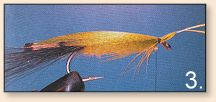 3. Select two dark-green [shown yellow here] dyed
mallard flank feathers; one should curve left and
one right with their concave sides down. After
stripping away the fluffy stuff at the base of
the feathers, the feathers should cover the body
and the golden pheasant tippet with laid over the
fly. Lay one feather on top of the other, concave
sides down, and hold them over the body so the bare
stems start at the head. Take two loose turns of
thread over the bare stems to hold them in place.
Draw the feathers forward by the stems until the
orange of the golden pheasant tippet on the tail
is exposed. You just need a 1/8 of an inch (2 mm)
to show. You will have to guide the feathers with
your left hand as you position the wing correctly.
You want the wing to sort of cup the body. Now,
take three tight wraps of thread to secure the wing.
Do not trim the feather stems.
3. Select two dark-green [shown yellow here] dyed
mallard flank feathers; one should curve left and
one right with their concave sides down. After
stripping away the fluffy stuff at the base of
the feathers, the feathers should cover the body
and the golden pheasant tippet with laid over the
fly. Lay one feather on top of the other, concave
sides down, and hold them over the body so the bare
stems start at the head. Take two loose turns of
thread over the bare stems to hold them in place.
Draw the feathers forward by the stems until the
orange of the golden pheasant tippet on the tail
is exposed. You just need a 1/8 of an inch (2 mm)
to show. You will have to guide the feathers with
your left hand as you position the wing correctly.
You want the wing to sort of cup the body. Now,
take three tight wraps of thread to secure the wing.
Do not trim the feather stems.
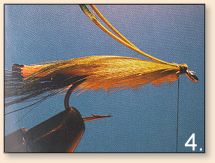 4. Make three more turns of thread forward in touching
turns. Now, grasp the feather stems, and fold them
right back over the feather. If this is done correctly,
you will now be able to secure the feathers with three
or four tight wraps of thread.
4. Make three more turns of thread forward in touching
turns. Now, grasp the feather stems, and fold them
right back over the feather. If this is done correctly,
you will now be able to secure the feathers with three
or four tight wraps of thread.
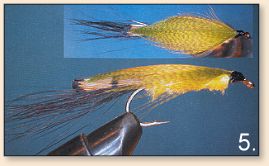
5. Trim the feathers stems now. Form a nice, neat head,
whip finish, cut the thread, and lacquer the head.
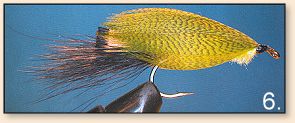
There are any number of colour combinations
of body and wing that you can use for this pattern.
Try a yellow body with a yellow wing or an orange
body with a reddish-brown wing. I have a friend
whose favourite colours are black body with a
garish bright-pink wing - a rather bizarre
combinations, but it seems to work.

In the yellow-green or orange/brown combinations
the Canadian Hamill's Killer is a pretty good
crawfish imi8tation. I find the yellow/green
seems to work in still water, while the orange/brown
works best in rivers. This might have something
to do with the colour of the crayfish in these
waters. I believe that the little point of orange
in the tail imitates the tips of the claws as a
crawfish flees backward from a fish. As for the
other colours, who can say? The all-yellow might
suggest a perch or similar small baitfish. The
black/pink may just attract their attention.
I do know that a Canadian Hamill's Killer catches
just about everything in the water - just the ticket
for browns, rainbows, steelhead, bass, and even walleye. ~ SS
Credit: Excerpt from the January/March 2004
issue of The Canadian Fly Fisher. We appreciate use
permission.
Our Man In Canada Archives
|

